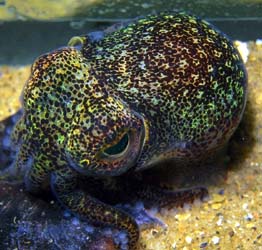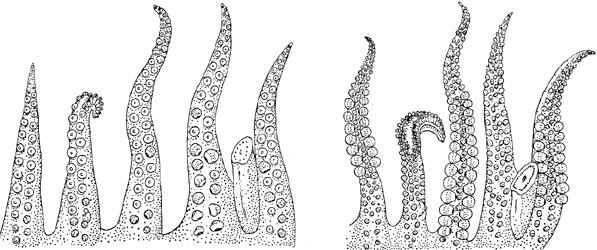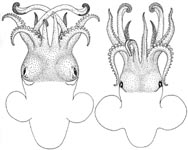Euprymna
Richard E. Young and Michael Vecchione- Euprymna albatrossae
- Euprymna berryi
- Euprymna hoylei
- Euprymna hyllebergi
- Euprymna morsei
- Euprymna penares?
- Euprymna phenax
- Euprymna scolopes
- Euprymna stenodactyla
- Euprymna tasmanica
Introduction
Species of Euprymna are small (up to a few cm in ML), benthic sepiolids sometimes found in water less than 1 m in depth.Diagnosis
A sepiolin ...
- with visceral photophores.
- with, usually, four sucker series on arms.
Characteristics
- Arms
- Arm suckers usually in four series; in two series in E. phenax.
- Hectocotylus - left arm I; also enlargement of suckers of marginal series of some other arms.
- Arms III not unusually thick and robust; rarely curled inward in preservation when other arms are not.
- Tentacles
- Tentacular clubs with suckers in more than 32 series.
- Photophores.
- Pair of bean-shaped visceral photophores.
 Click on an image to view larger version & data in a new window
Click on an image to view larger version & data in a new window
Figure. Ventral view of the visceral photophores of E. scolopes. The silvery reflectors are covered in their centers by extensions of the ink sac. The photogenic region of each reflector is medially located and the two organs are joined by a narrow duct. Photograph by R. Young.
- Gladius
- Gladius present as a distinct rudiment
References
Nesis, K. N. 1982/87. Abridged key to the cephalopod mollusks of the world's ocean. 385+ii pp. Light and Food Industry Publishing House, Moscow. (In Russian.). Translated into English by B. S. Levitov, ed. by L. A. Burgess (1987), Cephalopods of the world. T. F. H. Publications, Neptune City, NJ, 351pp.
Voss, G. L. 1963. Cephalopoda of the Philippine Islands. Bull. U. S. Nat. Mus., 234: 1-180.
About This Page

University of Hawaii, Honolulu, HI, USA

National Museum of Natural History, Washington, D. C. , USA
Page copyright © 1996 and
 Page: Tree of Life
Euprymna .
Authored by
Richard E. Young and Michael Vecchione.
The TEXT of this page is licensed under the
Creative Commons Attribution-NonCommercial License - Version 3.0. Note that images and other media
featured on this page are each governed by their own license, and they may or may not be available
for reuse. Click on an image or a media link to access the media data window, which provides the
relevant licensing information. For the general terms and conditions of ToL material reuse and
redistribution, please see the Tree of Life Copyright
Policies.
Page: Tree of Life
Euprymna .
Authored by
Richard E. Young and Michael Vecchione.
The TEXT of this page is licensed under the
Creative Commons Attribution-NonCommercial License - Version 3.0. Note that images and other media
featured on this page are each governed by their own license, and they may or may not be available
for reuse. Click on an image or a media link to access the media data window, which provides the
relevant licensing information. For the general terms and conditions of ToL material reuse and
redistribution, please see the Tree of Life Copyright
Policies.
Citing this page:
Young, Richard E. and Michael Vecchione. 1996. Euprymna . Version 01 January 1996 (under construction). http://tolweb.org/Euprymna/20036/1996.01.01 in The Tree of Life Web Project, http://tolweb.org/










 Go to quick links
Go to quick search
Go to navigation for this section of the ToL site
Go to detailed links for the ToL site
Go to quick links
Go to quick search
Go to navigation for this section of the ToL site
Go to detailed links for the ToL site